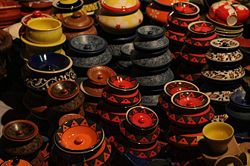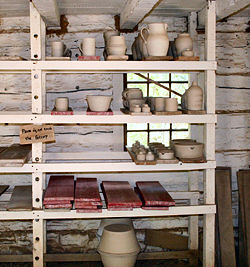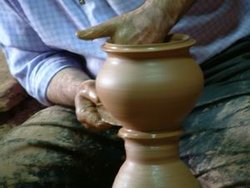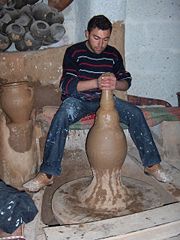Pottery, Ceramic
Pottery is the ceramic ware made by potters. It also refers to a group of materials that includes earthenware, stoneware, and porcelain. The places where such wares are made are called potteries. more...
Background
Pottery is made by forming a clay body into objects of a required shape and heating them to high temperatures in a kiln to induce reactions that lead to permanent changes, including increasing their strength and hardening and setting their shape. There are wide regional variations in the properties of clays used by potters and this often helps to produce wares that are unique in character to a locality. It is common for clays and other minerals to be mixed to produce clay bodies suited to specific purposes; for example, a clay body that remains slightly porous after firing is often used for making earthenware or terra cotta flower-pots.
Prior to most shaping processes, air trapped within the clay body needs to be removed. This is called de-airing and can be accomplished by a machine called a vacuum pug, or manually by wedging. Wedging can also help to ensure an even moisture content throughout the body. Once clay body has been de-aired or wedged, it is shaped by a variety of techniques. After shaping it is dried before firing. There are a number of stages in the drying process. Leather-hard refers to the stage when the clay object is approximately 75-85% dry. Trimming and handle attachment often occurs at the leather-hard state. A clay object is said to be "bone-dry" when it reaches a moisture content at or near 0%. Unfired objects are often termed greenware.
Methods of shaping
The potter's most basic tools are the hand, but many additional tools have been developed over the long history of pottery manufacture, including the potter's wheel and turntable, shaping tools (paddles, anvils, ribs), rolling tools (roulettes, slab rollers, rolling pins), cutting/piercing tools (knives, fluting tools, wires) and finishing tools (burnishing stones, rasps, chamois).
Pottery can be shaped by a range of methods that include:
Handwork or handbuilding. This is the earliest and the most individualized and direct forming method. Wares can be constructed by hand from coils of clay, from flat slabs of clay, from solid balls of clay — or some combination of these. Parts of hand-built vessels are often joined together with the aid of slurry or slip, a runny mixture of clay and water. Handbuilding is slower and more gradual than wheel-throwing, but it offers the potter a high degree of control over the size and shape of wares. While it isn't difficult for an experienced potter to make identical pieces of hand-built pottery, the speed and repetitiveness of wheel-throwing is more suitable for making precisely matched sets of wares such as table wares. Some potters find handbuilding more conducive to fully using the imagination to create one-of-a-kind works of art, while other potters find the spontaneity and immediacy of wheel-thrown pottery as their source of inspiration.
Read more at Wikipedia.org




